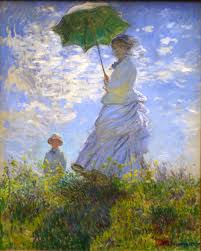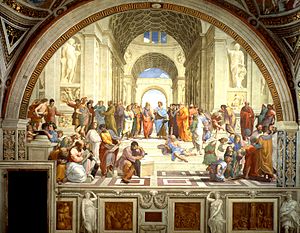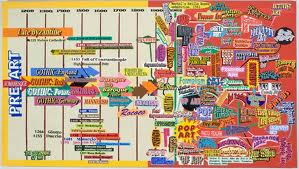 To know where Art is going, we must know where art has been. What is Art? It’s quite a loaded question. Art with a capital A. This is highly subjective, like what is good art or whether or not something is worthy bring called art. Art is a broad category of human activities that involves expression. The media that Art encompasses is vast like the Grand Canyon. It’s huge, like insanely huge. It’s movies, broadcasting, television, music, and Visual Arts, or Fine Arts. This is our slice of art. It’s actually what art is most often referred to, this section known as Visual Art or Fine Arts. Visual and Fine arts, what I studied in college, are, but are not limited to, paintings, drawings, sculpture, architecture, printmaking, advertising, textiles, and photography. These are media, the plural form of medium. That’s the artsy way of saying what kind of art. [I want to guys sounding educated when we’re speaking about your favorite subject. Subject in art is what you painted. Subject Matter is what kind of subject. You study art in different sections called medium(a). That’s my inner Art Teacher ranting and raving. Sorry. Hehe. ] Art can be studied over the whole span of Human History. Artists have been creating for thousands and thousands of years. I think being an artist is only natural, seeing as how they’ve always had a place in society and they’ve always been around, changing the world. It’s the DNA somewhere.
To know where Art is going, we must know where art has been. What is Art? It’s quite a loaded question. Art with a capital A. This is highly subjective, like what is good art or whether or not something is worthy bring called art. Art is a broad category of human activities that involves expression. The media that Art encompasses is vast like the Grand Canyon. It’s huge, like insanely huge. It’s movies, broadcasting, television, music, and Visual Arts, or Fine Arts. This is our slice of art. It’s actually what art is most often referred to, this section known as Visual Art or Fine Arts. Visual and Fine arts, what I studied in college, are, but are not limited to, paintings, drawings, sculpture, architecture, printmaking, advertising, textiles, and photography. These are media, the plural form of medium. That’s the artsy way of saying what kind of art. [I want to guys sounding educated when we’re speaking about your favorite subject. Subject in art is what you painted. Subject Matter is what kind of subject. You study art in different sections called medium(a). That’s my inner Art Teacher ranting and raving. Sorry. Hehe. ] Art can be studied over the whole span of Human History. Artists have been creating for thousands and thousands of years. I think being an artist is only natural, seeing as how they’ve always had a place in society and they’ve always been around, changing the world. It’s the DNA somewhere.
 Art History is “where Art has been” or the study of art’s journey through time. Some of the worst trends come back, like they do with clothing. Some classical trends transcend time, medium, geography and gender. The Italian Renaissance pulls from the aesthetic of Ancient Greek antiquity, like Michelangelo’s frauds, but also has heavy influence from the Flemish Renaissance, that came slightly before. We haven’t talked about Flanders or Flemish art yet, but I find a lot of parallels here between Van Eyke to the left and early Leonardo Da Vinci’s work, like the Annunciation. Modern Art pulls very little from antiquity but still benefits from all other art coming before it. We’ll discuss artists as well as artistic movements, which is compromised of several artists who may or may not have known each other around the same time frame who have a similar style, theories and/or message.
Art History is “where Art has been” or the study of art’s journey through time. Some of the worst trends come back, like they do with clothing. Some classical trends transcend time, medium, geography and gender. The Italian Renaissance pulls from the aesthetic of Ancient Greek antiquity, like Michelangelo’s frauds, but also has heavy influence from the Flemish Renaissance, that came slightly before. We haven’t talked about Flanders or Flemish art yet, but I find a lot of parallels here between Van Eyke to the left and early Leonardo Da Vinci’s work, like the Annunciation. Modern Art pulls very little from antiquity but still benefits from all other art coming before it. We’ll discuss artists as well as artistic movements, which is compromised of several artists who may or may not have known each other around the same time frame who have a similar style, theories and/or message.
 Movements within Art History mark a collective feeling or a generation within art. Movements often fit inside of larger categories and time periods within art, but some stand alone. Some movements have movements within movements. We’ve discussed Picasso’s Cubism Movement, but was a broad umbrella for a couple of movements happening simultaneously across Europe for a number of years. Russian Constructivism belongs to the larger Cubism movement. But even Picasso’s artwork is separated into smaller periods. Movements are how we discuss the changes in art. They can be pretty broad, too. Arts and Crafts is a larger category that includes several movements within art. The definition of Arts and Crafts is a decorative item that also has function, but weaving pot holders was huge for a time in the 50’s & 60’s and Shoe Art and my painted pots would fit in here today. Anything ending in an ism in our Art History studies is a movement for the most part.
Movements within Art History mark a collective feeling or a generation within art. Movements often fit inside of larger categories and time periods within art, but some stand alone. Some movements have movements within movements. We’ve discussed Picasso’s Cubism Movement, but was a broad umbrella for a couple of movements happening simultaneously across Europe for a number of years. Russian Constructivism belongs to the larger Cubism movement. But even Picasso’s artwork is separated into smaller periods. Movements are how we discuss the changes in art. They can be pretty broad, too. Arts and Crafts is a larger category that includes several movements within art. The definition of Arts and Crafts is a decorative item that also has function, but weaving pot holders was huge for a time in the 50’s & 60’s and Shoe Art and my painted pots would fit in here today. Anything ending in an ism in our Art History studies is a movement for the most part.
 So, Teacher Lila, why are we talking about artists and Art History when all we want is to learn about art? I already take history in school. Well, maybe I’m bias, but I find artists to be very interesting people. Exposing you to new art and new visuals is huge in giving you guys a solid art education. The inspiration, personal or visual, is endless in this pool of knowledge. What’s more important to me is what that artist was trying to say with his or her art, and we don’t know much of that unless we investigate a little bit into the character. We find out Van Gogh, who didn’t sell any paintings during his lifetime, had interesting strokes and colors, as well as the famed craziness and ear thing, due to mental illness probably as a result of inhaling toxic oil paints.
So, Teacher Lila, why are we talking about artists and Art History when all we want is to learn about art? I already take history in school. Well, maybe I’m bias, but I find artists to be very interesting people. Exposing you to new art and new visuals is huge in giving you guys a solid art education. The inspiration, personal or visual, is endless in this pool of knowledge. What’s more important to me is what that artist was trying to say with his or her art, and we don’t know much of that unless we investigate a little bit into the character. We find out Van Gogh, who didn’t sell any paintings during his lifetime, had interesting strokes and colors, as well as the famed craziness and ear thing, due to mental illness probably as a result of inhaling toxic oil paints.
Why do I feel like knowing about artists is important to a young, modern artist? I just do. Hahaha! Nah, seriously. Your art, too, can speak and change a generation. I have a firm belief that the change the world takes happens in art first. Art changes the world and marks the changes of the world. If you feel that you know what you wanna say right now, we can work towards that by making sound comparisons with other artists. I like saying “peace” with my art, but I also pull from other inspirations of color, form and messages imbedded in Art History. Your art says a lot about what you know. Your art speaks volumes about you as a person.
 Art History started with cave paintings and ends with our pencils and papers but will go on as long as artists are creating. We are a speck of dust compared to all the people who have ever picked up a paint brush or pencil throughout Mankind. Many academic artists do not get recognized at all, despite having some of the most technically sound art. Academic art, or Art of the Academy, is high on technical finesse and low on meaning. It’s frivolous and pretty, not groundbreaking and innovative. Fine artists with things to say who cannot sell their art or talk about their message end up left off these timelines for the most part. Those simply ahead of their time find fame after life, like Van Gogh. Thousands of highly creative and innovative individuals and artists do not appear on this list.
Art History started with cave paintings and ends with our pencils and papers but will go on as long as artists are creating. We are a speck of dust compared to all the people who have ever picked up a paint brush or pencil throughout Mankind. Many academic artists do not get recognized at all, despite having some of the most technically sound art. Academic art, or Art of the Academy, is high on technical finesse and low on meaning. It’s frivolous and pretty, not groundbreaking and innovative. Fine artists with things to say who cannot sell their art or talk about their message end up left off these timelines for the most part. Those simply ahead of their time find fame after life, like Van Gogh. Thousands of highly creative and innovative individuals and artists do not appear on this list.
I’d love to find a list of the Technology Arts, it’s included in limited form on one of the timelines below, because there’s a wealth of great art there and where I find most of today’s art. I wish I had enough time to compile my own timeline, but I do not. I cannot take credit for these visuals below. Again, more creative individuals than I prevail.
 So, where does it fit into our class? Art History provides us with inspiration and exposure to new theories, techniques and visuals. Art History can answer a lot of our questions as to “why?”. Art History can show us how other artists put their message out there and therefore, how we can get our message out there. It shows us how art has changed through time. Some of the most beautiful art is created out of some really ugly history. Some of the most popular artwork comes out of ugly rivalries where there were winners and losers. Art is expression and there are so many people out there with the natural ability and compulsion to do so.
So, where does it fit into our class? Art History provides us with inspiration and exposure to new theories, techniques and visuals. Art History can answer a lot of our questions as to “why?”. Art History can show us how other artists put their message out there and therefore, how we can get our message out there. It shows us how art has changed through time. Some of the most beautiful art is created out of some really ugly history. Some of the most popular artwork comes out of ugly rivalries where there were winners and losers. Art is expression and there are so many people out there with the natural ability and compulsion to do so.
 We will eventually cover enough Art History that you’ll know by style what area of the world and what time frame you’re looking at by sight. You’ll know which of the following timelines you’re pulling from. I’ve found very different timelines. These are fun, but they’re showing up small. Some are of the entire span of Art History and some that are just of Modern History. I want you to get the feeling of the tiny pin prick of a dot on this line that we are. In my humble opinion, I think the first historians were artists painting on cave walls, their cathedrals of the time. Again, this is subject, this is broad and general. This is Art History at a glance.
We will eventually cover enough Art History that you’ll know by style what area of the world and what time frame you’re looking at by sight. You’ll know which of the following timelines you’re pulling from. I’ve found very different timelines. These are fun, but they’re showing up small. Some are of the entire span of Art History and some that are just of Modern History. I want you to get the feeling of the tiny pin prick of a dot on this line that we are. In my humble opinion, I think the first historians were artists painting on cave walls, their cathedrals of the time. Again, this is subject, this is broad and general. This is Art History at a glance.





what am i supposed to do with this thumbnail?
The learning and connection happens when you make your own. I’ve done it with students. It’s a lot of fun. But I couldn’t find a larger version. Sorry.
What program did you use to create your web page?
Wonderful
I am a high school art teacher and wanted to improve my web page
Thanks
Hi there! Sorry about the late reply. I’m using wordpress. These articles are my own. I’m an independent art teacher reinforcing her Curriculum with blogs. It’s not art for dummies. It’s art for smart kids.